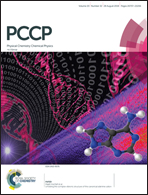Interaction of liquid water with the p-GaInP2(100) surface covered with submonolayer oxide
Abstract
High-resolution surface-sensitive synchrotron radiation photoelectron spectroscopy was used to study the interaction of water with the p-GaInP2(100) surface covered with submonolayer residual native oxide in order to get insight into water dissociation at the solar water-splitting photocathodes in real liquid environment. In the surface-sensitive valence band spectra features related to Ga–OH, In–OH, and H–In–OH bonds appear after emersion of the p-GaInP2(100) surface from liquid water at room temperature. Indium core levels remain intact after emersion, while the gallium core levels indicate transformation of gallium oxides to hydroxides, as well as the accumulation of metallic gallium. Surface sensitive P 2p core level spectra indicate formation of P–H bonds after emersion. These changes of the surface chemical bonds can be attributed to the dissociation of the water molecules on the p-GaInP2(100) surface, leading to the subsequent transformation of surface oxides to hydroxides. Interaction of water with the p-GaInP2(100) surface covered with submonolayer residual native oxide causes an increase in the work function by 80 meV and a modification of the valence band edge spectrum, which is evidence of a change of the surface dipole due to the charge redistribution induced by the transformation of the surface oxides to hydroxides.



 Please wait while we load your content...
Please wait while we load your content...